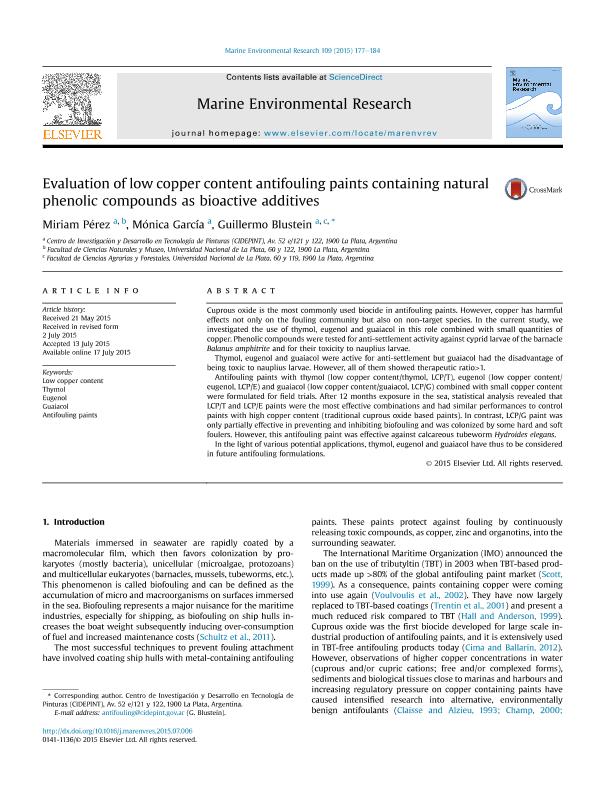Mostrar el registro sencillo del ítem
dc.contributor.author
Perez, Miriam Cristina

dc.contributor.author
García, Mónica
dc.contributor.author
Blustein, Guillermo

dc.date.available
2017-01-11T19:43:08Z
dc.date.issued
2015-08
dc.identifier.citation
Perez, Miriam Cristina; García, Mónica; Blustein, Guillermo; Evaluation of low copper content antifouling paints containing natural phenolic compounds as bioactive additives; Elsevier; Marine Environmental Research; 109; 8-2015; 177-184
dc.identifier.issn
0141-1136
dc.identifier.uri
http://hdl.handle.net/11336/11147
dc.description.abstract
Cuprous oxide is the most commonly used biocide in antifouling paints. However, copper has harmful effects not only on the fouling community but also on non-target species. In the current study, we investigated the use of thymol, eugenol and guaiacol in this role combined with small quantities of copper. Phenolic compounds were tested for anti-settlement activity against cyprid larvae of the barnacle Balanus amphitrite and for their toxicity to nauplius larvae. Thymol, eugenol and guaiacol were active for anti-settlement but guaiacol had the disadvantage of being toxic to nauplius larvae. However, all of them showed therapeutic ratio>1. Antifouling paints with thymol (low copper content/thymol, LCP/T), eugenol (low copper content/ eugenol, LCP/E) and guaiacol (low copper content/guaiacol, LCP/G) combined with small copper content were formulated for field trials. After 12 months exposure in the sea, statistical analysis revealed that LCP/T and LCP/E paints were the most effective combinations and had similar performances to control paints with high copper content (traditional cuprous oxide based paints). In contrast, LCP/G paint was only partially effective in preventing and inhibiting biofouling and was colonized by some hard and soft foulers. However, this antifouling paint was effective against calcareous tubeworm Hydroides elegans. In the light of various potential applications, thymol, eugenol and guaiacol have thus to be considered in future antifouling formulations.
dc.format
application/pdf
dc.language.iso
eng
dc.publisher
Elsevier

dc.rights
info:eu-repo/semantics/openAccess
dc.rights.uri
https://creativecommons.org/licenses/by-nc-nd/2.5/ar/
dc.subject
Thymol
dc.subject
Eugenol
dc.subject
Guaiacol
dc.subject
Antifouling Paints
dc.subject
Low Copper Content
dc.subject.classification
Otras Ciencias Naturales y Exactas

dc.subject.classification
Otras Ciencias Naturales y Exactas

dc.subject.classification
CIENCIAS NATURALES Y EXACTAS

dc.title
Evaluation of low copper content antifouling paints containing natural phenolic compounds as bioactive additives
dc.type
info:eu-repo/semantics/article
dc.type
info:ar-repo/semantics/artículo
dc.type
info:eu-repo/semantics/publishedVersion
dc.date.updated
2017-01-11T19:17:56Z
dc.journal.volume
109
dc.journal.pagination
177-184
dc.journal.pais
Países Bajos

dc.journal.ciudad
Amsterdam
dc.description.fil
Fil: Perez, Miriam Cristina. Consejo Nacional de Investigaciones Científicas y Técnicas. Centro Científico Tecnológico la Plata. Centro de Investigación y Desarrollo En Tecnología de Pinturas (i); Argentina. Universidad Nacional de La Plata. Facultad de Ciencias Naturales y Museo; Argentina
dc.description.fil
Fil: García, Mónica. Consejo Nacional de Investigaciones Científicas y Técnicas. Centro Científico Tecnológico La Plata. Centro de Investigación y Desarrollo en Tecnología de Pinturas (i); Argentina
dc.description.fil
Fil: Blustein, Guillermo. Consejo Nacional de Investigaciones Científicas y Técnicas. Centro Científico Tecnológico la Plata. Centro de Investigación y Desarrollo En Tecnología de Pinturas (i); Argentina. Universidad Nacional de La Plata. Facultad de Ciencias Agrarias y Forestales; Argentina
dc.journal.title
Marine Environmental Research

dc.relation.alternativeid
info:eu-repo/semantics/altIdentifier/doi/http://dx.doi.org/10.1016/j.marenvres.2015.07.006
dc.relation.alternativeid
info:eu-repo/semantics/altIdentifier/url/http://www.sciencedirect.com/science/article/pii/S0141113615300131
Archivos asociados
